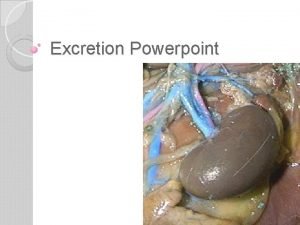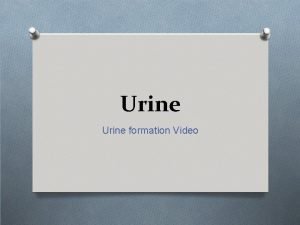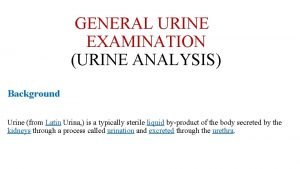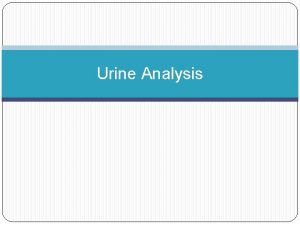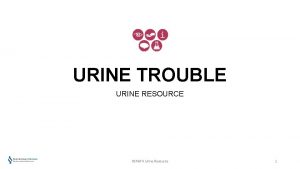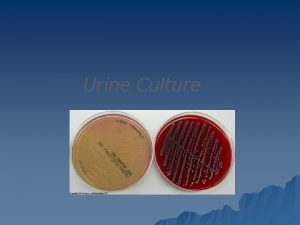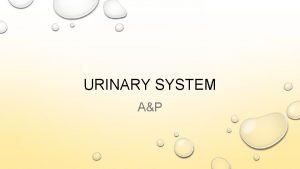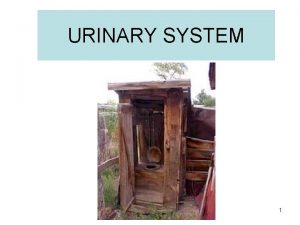The Urinary System Why how is urine used














- Slides: 14

The Urinary System

Why / how is urine used to determine if individuals have various disorders?

The Kidneys • Kidneys play a key role in removing waste, balancing blood p. H and maintaining water balance.

Metabolic Wastes Waste Origin of Waste Organ of Excretion Ammonia Deamination of a. a. by liver Urea Uric Acid Two ammonia combine with CO 2 Byproduct of nucleic acid breakdown (e. g. , DNA) kidneys

The Kidneys… • Each kidney has a mass of 150 g and are the size of your fist. • They hold 25% of the body’s blood. • They filter 200 L of fluid each day!

The Urinary System • Wastes filtered by the kidneys travel along the ureters to the urinary bladder. • A urinary sphincter is found at the base of the bladder. – Upon relaxation, urine enters the urethra and it is voided.

The Urinary System

Bladder Capacity • 200 ml: stretch receptors send impulses to the brain; urge to urinate. • 400 ml: more receptors activated & higher frequency of impulses; feeling of urination more urgent. • 600 ml: voluntary control is lost; micturition reflex occurs.

The 3 Regions of the Kidney • Renal Cortex • Renal Medulla • Renal Pelvis

Nephrons • Over 1 million per kidney. • The smallest functional units of the kidneys.

Nephrons • Afferent arterioles from the renal artery branch into a capillary bed (glomerulus). – Supplies the nephrons with blood. • Blood leaves via efferent arterioles that form the peritubular capillaries that wrap around the nephron.

Nephrons • Bowman’s capsule surrounds the glomerulus. • Water and other solutes filter into the Bowman’s capsule.

Nephrons • The capsule tapers off into the proximal tubule. • Carries the filtrate to the loop of Henle. • Filtrate passes through the distal tubule and then the collecting ducts. • The collecting ducts collect urine from many nephrons, which merge in the renal pelvis.

 Dari hasil tes ternyata urin pak yudha mengandung glukosa
Dari hasil tes ternyata urin pak yudha mengandung glukosa Why why why why
Why why why why Red and white blood cells difference
Red and white blood cells difference Physiology of urine formation
Physiology of urine formation Figure 15-3 the urinary system
Figure 15-3 the urinary system Combining form for urinary bladder
Combining form for urinary bladder Urinary system interesting facts
Urinary system interesting facts Pig male reproductive system
Pig male reproductive system The urinary system chapter 30
The urinary system chapter 30 Chapter 15 the urinary system figure 15-3
Chapter 15 the urinary system figure 15-3 Chapter 20 urinary/excretory system
Chapter 20 urinary/excretory system Urinary system model
Urinary system model Urinary system model
Urinary system model Placoid scales definition
Placoid scales definition Urinary system powerpoint
Urinary system powerpoint














